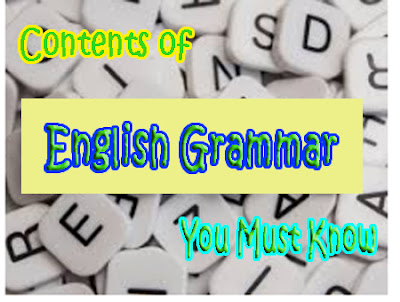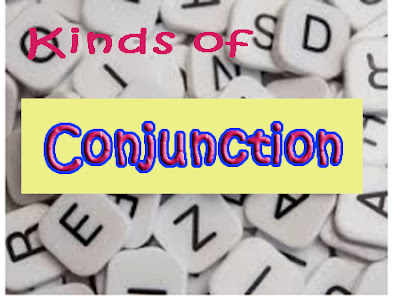English Grammar : Contents of Grammar
English Grammar : Contents of Grammar
Grammar is the one of imfortant thing to master when we want to speak well, and not only that but also we can be better in the fourth aspects ( speaking, listening, reading, and writing). So that way no reason to not learn about grammar, and in this section we share the contents or part of grammar, here they are;
Adjectives
Adjectives describe or give
information about nouns.
The good news is that the
form of adjectives does not change; it does not matter if the noun being modified
is male or female, singular or plural, subject or object.
Some adjectives give us
factual information about the noun - age, size colour etc (fact adjectives -
can't be argued with). Some adjectives show what somebody thinks about
something or somebody - nice, horrid, beautiful etc (opinion adjectives - not
everyone may agree).
Preposition
A preposition links nouns,
pronouns and phrases to other words in a sentence. The word or phrase that the
preposition introduces is called the object of the preposition.
A preposition usually
indicates the temporal, spatial or logical relationship of its object to the
rest of the sentence as in the following examples:
- The book is on the table.
- The book is beneath the table.
- The book is leaning against the table.
- The book is beside the table.
- She held the book over the table.
- She read the book during class.
In each of the preceding
sentences, a preposition locates the noun "book" in space or in time.
A prepositional phrase is made up of the preposition, its object and any
associated adjectives or adverbs. A prepositional phrase can function as a
noun, an adjective, or an adverb. The most common prepositions are "about," "above,"
"across," "after," "against," "along,"
"among," "around," "at," "before,"
"behind," "below," "beneath," "beside,"
"between," "beyond," "but," "by,"
"despite," "down," "during," "except,"
"for," "from," "in," "inside,"
"into," "like," "near," "of,"
"off," "on," "onto," "out,"
"outside," "over," "past," "since,"
"through," "throughout," "till," "to,"
"toward," "under," "underneath,"
"until," "up," "upon," "with,"
"within," and "without."
Each of the highlighted
words in the following sentences is a preposition:
The children climbed the
mountain without fear.
In this sentence, the
preposition "without" introduces the noun "fear." The
prepositional phrase "without fear" functions as an adverb describing
how the children climbed.
There was rejoicing
throughout the land when the government was defeated.
Here, the preposition
"throughout" introduces the noun phrase "the land." The
prepositional phrase acts as an adverb describing the location of the
rejoicing.
The spider crawled slowly
along the banister.
The preposition
"along" introduces the noun phrase "the banister" and the
prepositional phrase "along the banister" acts as an adverb,
describing where the spider crawled.
The dog is hiding under the
porch because it knows it will be punished for chewing up a new pair of shoes.
Here the preposition
"under" introduces the prepositional phrase "under the
porch," which acts as an adverb modifying the compound verb "is
hiding."
The screenwriter searched
for the manuscript he was certain was somewhere in his office.
Similarly in this sentence,
the preposition "in" introduces a prepositional phrase "in his office,"
which acts as an adverb describing the location of the missing papers.
Definition and kinds of Conjunction
You can use a conjunction to
link words, phrases, and clauses, as in the following example:
I ate the pizza and the
pasta.
Call the movers when you are
ready.
- Coordinating
Conjunctions
You use a coordinating
conjunction ("and," "but," "or," "nor,"
"for," "so," or "yet") to join individual words,
phrases, and independent clauses. Note that you can also use the conjunctions
"but" and "for" as prepositions.
In the following sentences,
each of the highlighted words is a coordinating conjunction:
Lilacs and violets are
usually purple.
In this example, the
coordinating conjunction "and" links two nouns.
This movie is particularly
interesting to feminist film theorists, for the screenplay was written by Mae
West.
In this example, the
coordinating conjunction "for" is used to link two independent
clauses.
Daniel's uncle claimed that
he spent most of his youth dancing on rooftops and swallowing goldfish.
Here the coordinating
conjunction "and" links two participle phrases ("dancing on
rooftops" and "swallowing goldfish") which act as adverbs
describing the verb "spends."
- Subordinating
Conjunctions
A subordinating conjunction
introduces a dependent clause and indicates the nature of the relationship
among the independent clause(s) and the dependent clause(s).
The most common
subordinating conjunctions are "after," "although,"
"as," "because," "before," "how," "if,"
"once," "since," "than," "that,"
"though," "till," "until," "when,"
"where," "whether," and "while."
Each of the highlighted
words in the following sentences is a subordinating conjunction:
After she had learned to
drive, Alice felt more independent.
The subordinating
conjunction "after" introduces the dependent clause "After she
had learned to drive."
If the paperwork arrives on
time, your cheque will be mailed on Tuesday.
Similarly, the subordinating
conjunction "if" introduces the dependent clause "If the
paperwork arrives on time."
Gerald had to begin his
thesis over again when his computer crashed.
The subordinating
conjunction "when" introduces the dependent clause "when his
computer crashed."
Midwifery advocates argue
that home births are safer because the mother and baby are exposed to fewer
people and fewer germs.
In this sentence, the
dependent clause "because the mother and baby are exposed to fewer people
and fewer germs" is introduced by the subordinating conjunction
"because."
- Correlative
Conjunctions
Correlative conjunctions
always appear in pairs -- you use them to link equivalent sentence elements.
The most common correlative conjunctions are "both...and,"
"either...or," "neither...nor,", "not only...but also,"
"so...as," and "whether...or." (Technically correlative
conjunctions consist simply of a coordinating conjunction linked to an
adjective or adverb.)
The highlighted words in the
following sentences are correlative conjunctions:
Both my grandfather and my
father worked in the steel plant.
In this sentence, the
correlative conjunction "both...and" is used to link the two noun
phrases that act as the compound subject of the sentence: "my
grandfather" and "my father".
Bring either a Jello salad
or a potato scallop.
Here the correlative
conjunction "either...or" links two noun phrases: "a Jello
salad" and "a potato scallop."
Corinne is trying to decide
whether to go to medical school or to go to law school.
Similarly, the correlative
conjunction "whether ... or" links the two infinitive phrases
"to go to medical school" and "to go to law school."
The explosion destroyed not
only the school but also the neighboring pub.
In this example the
correlative conjunction "not only ... but also" links the two noun
phrases ("the school" and "neighboring pub") which act as
direct objects.



0 Response to "English Grammar : Contents of Grammar"
Post a Comment